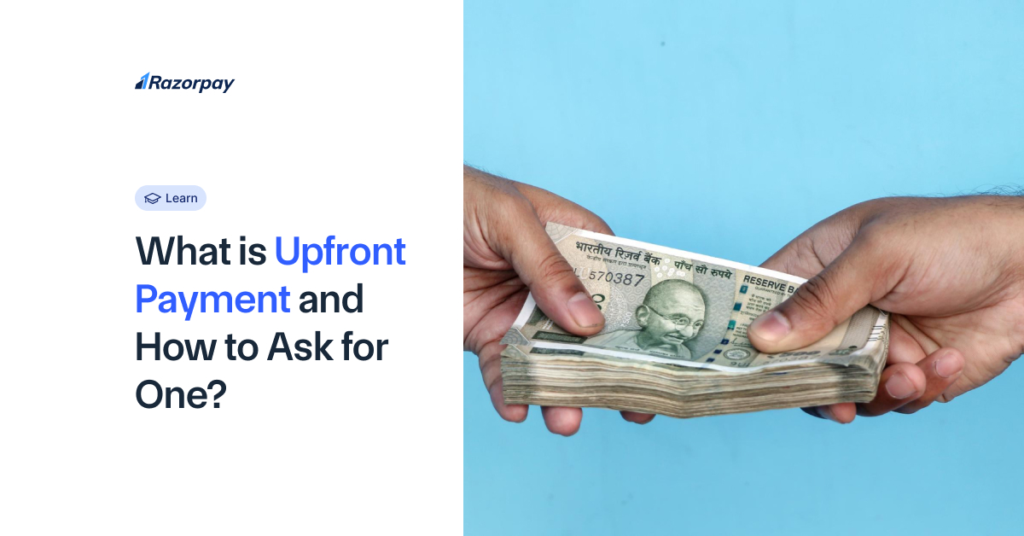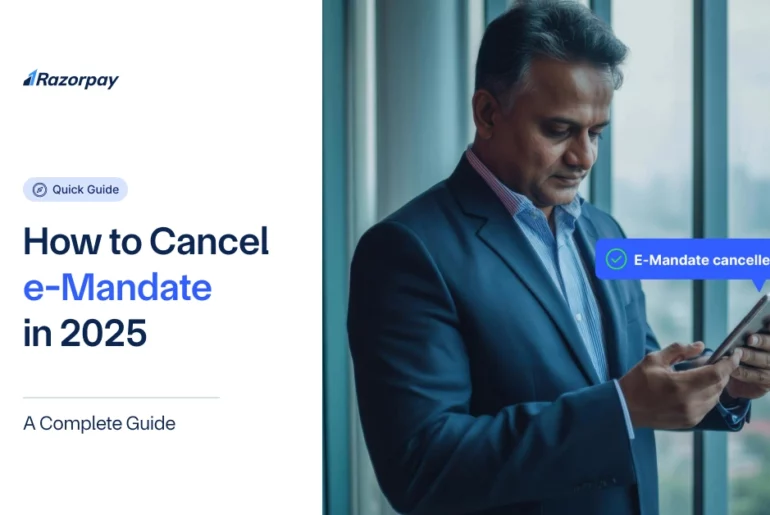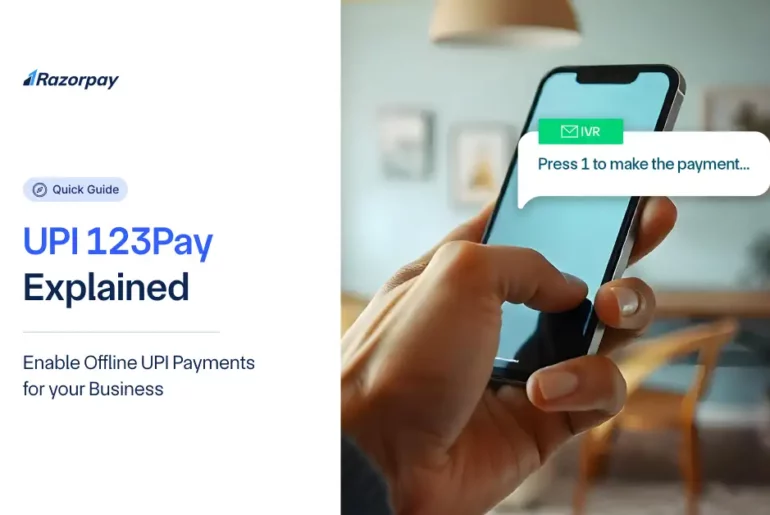Table of Contents
What is Upfront Payment?
An Upfront payment or advance payment is a full or partial amount paid by a customer before a service or product is delivered to the client. This practice is common in various industries such as freelancers, consultants, and service providers.
Related Read: What is Deferred Payment and How Does It Work?
How do Upfront Payment Works on Buyer’s Perspective?
STEP 1: Initiation
The buyer agrees to the seller’s terms for payment. They review the payment request. This includes the total amount due and the payment schedule.
STEP 2: Payment Methods
The buyer selects a preferred method of payment from the different types of payment methods provided by the seller. Common methods are credit cards, debit cards, bank transfers, or digital wallets.
STEP 3: Payment Processing
The buyer completes the transaction through the seller’s chosen payment gateway like Razorpay. They receive a confirmation of the payment in the form of a receipt or email.
STEP 4: Goods/Services Receipt
After the payment is processed, the buyer awaits the delivery of goods or services as per the agreed-upon timeline.
How do Upfront Payment Works on Seller’s Perspective?
STEP 1: Payment Request
The seller issues a payment request which communicates the payment schedule and accepted payment methods
STEP 2: Payment Reception
The seller receives the payment through a chosen payment method
STEP 3: Order Processing
Upon confirmation of payment, the order is fulfilled by the seller
STEP 4: Refund Policy
The seller should have a clear refund policy in place when goods or services cannot be delivered as promised
What are the Payment Methods for Upfront Payments?
- Credit or debit cards are convenient and widely accepted by sellers
- Bank transfers are suitable for larger transactions and may incur lower processing fees compared to card payments
- Digital wallets can become an effective tool to make transactions instantly
How Upfront Payments are Secured?
- Reputable Payment Gateways: During upfront payment, clients trust the business with their financial information. Hence, a reputable payment gateway is required with adequate encryption and fraud detection mechanisms.
- Robust Data Protection: Ensure the client’s sensitive financial data is not compromised during the transaction. Implement strong data protection measures, such as secure, encrypted connections.
Examples of Upfront Payments from Various Industries
1. Example of Upfront Payment from E-commerce Industries
E-commerce platforms ask for prepayment to minimise financial risks and ensure smooth order fulfillment.
Examples include:
- Digital downloads (e.g., software, e-books, music)
- Physical goods from online retailers
- Pre-orders for upcoming product releases
2. Example of Upfront Payment from Service Industries
Service-based businesses require prepayment to avoid last-minute cancellations and reduce potential losses. This practice is common where time and resources are allocated in advance.
Examples include:
- Event planning: Clients pay a deposit to reserve a date and cover initial expenses
- Consulting: Consultants require a percentage-based payment upfront before starting a project
- Software development: Companies request a flat-rate deposit before starting custom software projects
3. Example of Upfront Payment from Subscription-Based Services
Recurring services require subscription fees paid up front as part of their business model. They also offer discounts for longer commitments.
Examples include:
- Streaming platforms (e.g., Netflix, Spotify)
- Software as a Service (SaaS) products
- Gym memberships
4. Example of Upfront Payment from Education and Training
The education sector asks for prepayment for courses, workshops, and certifications. This helps institute manage their cost and reduce the risk of student dropouts or non-payment.
Examples include:
- Online courses and MOOCs (Massive Open Online Courses)
- Professional certifications and exams
- In-person workshops and seminars
5. Example of Upfront Payment from Rental and Lease Agreements
In the real estate industries, prepayment takes the form of security deposits or the first month’s rent. This protects owners from potential damages or non-payment of rent.
Examples include:
- Apartment rentals: Security deposit plus first month’s rent
- Car leases: Down payment or security deposit
- Equipment rentals: Deposit for high-value items
When Should you Consider Requesting Upfront Payment?
Requesting upfront payment is beneficial for both businesses and clients in several situations. While they provide instant cash flow to the business, clients know the full cost upfront rather than facing unexpected charges later.
Prepayment can be requested under the following scenarios:
Scenario 1: Managing Cash Flow Requirements
For businesses with tight cash flow, prepayments are crucial, especially when materials need to be purchased in advance. Receiving a portion of the payment before starting work helps maintain sufficient working capital to cover initial expenses.
Scenario 2: Engaging with a New Client
Working with new clients always carries some risk. Requesting a deposit or partial payment can reduce this risk and show the client’s commitment to the project. This is important for freelancers who may not have the resources to absorb losses from non-paying clients.
Scenario 3: Undertaking a Long-Term Project
Long-term projects require a significant investment of time and resources. Prepayment helps maintain a steady cash flow throughout the project. Clearly outlining these payment terms in your contract is essential to avoid confusion or disputes later on.
Advantages of Upfront Payment
1. Covers Overhead Costs and Ensures Quality Focus:
- Focus on service quality without financial worry
- Eliminates chasing late payments
- Ensures steady cash flow
2. Establishes Trust and Demonstrates Commitment
- Dedication to the project and assured outcomes
- Better collaboration between seller and client with coordinated outcomes
3. Enhances Professional Profile
- Attracts serious clients with a genuine respect for the seller’s business
- Improved significance and dignity for the seller
- Exhibits a professional outlook for the seller who understands their market worth
- Attracts better-quality projects
Drawback of Upfront Payment Request
One of the primary drawbacks of requesting prepayment is potential client hesitation if they’re unfamiliar with your work.
To address these challenges consider the following strategies:
- Develop a strong online presence with a portfolio, case studies, and testimonials to showcase your expertise
- Communicate transparently about the mutual benefits of such payment, such as focused attention and faster completion.
- Offer guarantees or refund policies to reduce perceived risk.
- For new clients, consider starting with smaller projects or paid trials to build trust before larger commitments.
How to Ask for Upfront Payment? A Step-by-Step Guide
STEP 1: Recognise Your Worth
Research industry standards to determine the appropriate pricing for your services.
This involves:
- Consulting professional associations
- Networking with peers
- Analyzing market rates
Gather hard facts and figures to support your pricing during negotiations.
This includes:
- Data on your past project successes
- Client testimonials
- Industry benchmarks
STEP 2: Establish a Fair Pricing Structure
- Provide a comprehensive rate with a set fee for the full project to avoid hidden surprises for the client
- Ensure that your pricing reflects the quality and expertise of your work
- Consider factors such as project complexity, timeline, and required resources when setting your rates
STEP 3: Implement A Rational Upfront Payment Protocol
- Clearly define fair payment terms
- While 100% prepayment is rare, consider requesting 25-50% of the total bill before starting the project
- Alternatively, set up a series of installments, with payments made at different project milestones
STEP 4: Ensure Clarity In Project Terms
- Provide a comprehensive price quote that clearly explains your methodology, expected outcomes, and project timeline
- In your prepayment details, mention the range of services covered and any supplementary offerings
- Ensure that the client has a clear grasp of the value they’re receiving in exchange for their payment
Tips for Securing Upfront Payment
1. Building Credibility
Develop a well-organised portfolio or website that highlights:
- Case studies and success stories
- Relevant certifications or qualifications
- Display client testimonials and reviews
- Share references from reputable clients
- Showcase any awards or recognition
2. Maintaining Transparent Communication
Explain to your clients why this payment structure is necessary by:
- Breaking down costs, deliverables, and timelines so clients understand what they’re paying for.
- Communicating how advance payment helps you deliver better results and commitment to the project.
3. Emphasising Mutual Benefits
- Prepayment guarantees compensation for your work, and the client is assured of your full commitment to the project.
4. Using a Reliable Payment System
- Implement a robust payment gateway to streamline the payment process. This makes it easier for clients to submit payments quickly and securely.
- Utilise effective accounting software to track paid and unpaid invoices efficiently. This helps you maintain clear financial records and follow up on payments promptly.
Upfront Payments vs Credit Card Payment
Upfront payment helps buyers control spending but needs immediate funds. Credit cards allow purchases without immediate funds and offer rewards. However, they can lead to debt and interest charges. Sellers get immediate funds when paid up front. Credit cards provide a payment system but have higher fees and delayed fund access for sellers.
Upfront Payments vs Installment Payment
Upfront payment suits for cheaper items or immediate services. Installments spread costs over time. They work for expensive items like furniture, electronics or real estate. Installments make pricey items more accessible. But they complicate payment processing and risk buyer default.
Upfront Payments vs Cash on Delivery (COD)
Upfront payment secures purchases quickly and offers discounts, but requires buyer trust. Sellers prefer this method due to lower fees. COD allows item inspection before payment, and suits expensive or delicate items. However, COD has limited availability, higher fees, and refusal risks. It can cause delayed payments and return costs for sellers.
Upfront Payments vs. Buy Now, Pay Later (BNPL)
Upfront payment makes consumers buy carefully. This can reduce sales for businesses. BNPL lets consumers spread payments over time. This often increases spending. It can boost short-term revenue for businesses. However, businesses wait longer for full payment. This may cause cash flow problems. BNPL can also lead to financial stress for consumers.
Frequently Asked Questions
1. What Is An Upfront Transaction?
An upfront transaction involves paying for goods or services before receiving them. This is common in retail, travel, and subscriptions, benefiting sellers with immediate cash flow and buyers with potential discounts. Risks include non-delivery by the seller.
2. Why Is Upfront Payment Better?
Upfront payment improves cash flow and reduces financial risks for businesses, while offering buyers potential discounts and better protection, particularly in international transactions.
3. What Is An Example Of An Upfront Fee?
An example is a booking fee charged by event organizers before the event takes place.
4. Is Upfront Payment Refundable?
The refundability of a prepayment depends on the terms of the agreement:
- Deposits: These may be refundable.
- Retainer Fees: Typically non-refundable, especially if the service provider has already begun work.
- Down Payments: Some may be non-refundable if you cancel the agreement after payment.
5. Is Upfront Payment A Deposit?
A deposit is a specific type of prepayment that acts as collateral. The key differences between them are as follows:
- Purpose: A prepayment covers initial costs. A deposit is primarily security against fulfilling contract terms.
- Refundability: Deposits are usually refundable if conditions are met, while prepayments are often non-refundable unless stated otherwise.



